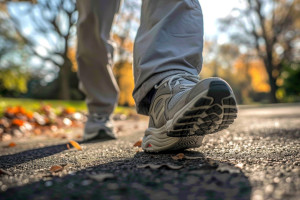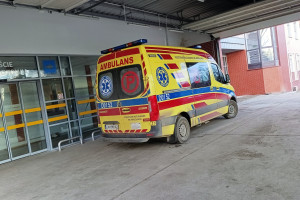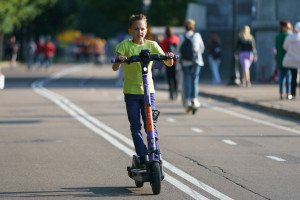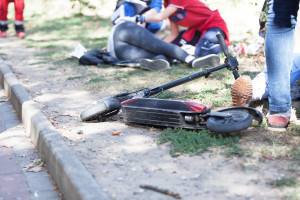Scooter at 100 km/h. Scalping of the head, face, crushed limbs. Will it end with just helmets?

- On July 21st, a 12-year-old boy died in Żywiec County. He was found near the S1 expressway with serious head injuries. An electric scooter was lying nearby. The 12-year-old was not wearing a helmet.
- It's easy to find online offers for scooters that can reach speeds of up to 100 km/h. The muzzle for the legal speed of 20 km/h is electronic, so it's easy to remove.
- "Children going 50 km/h are more likely to fall and hit the ground. A helmet without a chin guard will cause a broken jaw. No helmet can cause intracranial hematoma, brain swelling, concussion, or death. And if a child scrapes the asphalt while braking with their face, there may not be much skin left," warns surgeon Oskar Zgraj.
- Due to the exponential increase in scooter accidents, the Ministry of Infrastructure wants to introduce mandatory helmets for people under 16. The list includes e-scooters, but also regular and electric bicycles, two-wheeled Segways, and so-called electric wheels.
- Doctors support the idea, but emphasize that the number of injuries won't decrease dramatically. Some also argue that helmets can be... harmful when used with regular bikes.
Statistics kept by the National Police Headquarters for the first half of 2025 , made available to us by the Ministry of Infrastructure, indicate that road accidents involving electric scooters resulted in four deaths during that time. During the same period, 65 cyclists died.
"Our fastest scooter is the electric scooter (...) – you can reach speeds of up to 100 km/h," we read on one store's website. If regulations were to be followed, such a vehicle would be registered as a motorcycle, requiring a helmet and appropriate licenses. The maximum legal speed for an electric scooter in Poland is 20 km/h . An electric bicycle, on the other hand, can have a motor of up to 250 watts, which stops providing assistance after exceeding 25 km/h.
Electronic speed limiters are mandatory, but they're usually very easy to disable. Sometimes, you can even get instructions on how to do it in-store. "While large chains (Bolt, Tier) ensure speed limits are adhered to, recreational vehicle rental companies often remove this protection upon request. And then it's 40-80 km/h," Dr. Oskar Zgraj , a pediatric surgery specialist known online as @fajnychirurg, told Rynek Zdrowia.
Police are just beginning to use mobile dynamometers, which make it relatively easy to check the performance of scooters and bicycles during roadside checks. In practice, this is still rare, so adult users, while effectively riding a moped or motorcycle, legally ride on the road without helmets or a license.
"There's also the whole trend of buying electric scooters for First Communion . They don't have speed limits (editor's note) or they come with instructions on how to deactivate them with a combination of keystrokes on the scooter. After all, young people are finding their own ways to use individual models online," explains Oskar Zgraj.
The number of accidents on electric scooters is growing exponentially.
"In smaller towns, injuries involving bicycles and scooters account for about 20 percent (of all injuries - ed.). In Warsaw, according to the head of the Emergency Department at the hospital on Żwirki i Wigury Street, the figure is about 50 percent. These are alarming numbers ," comments Prof. Beata Jurkiewicz , national consultant in pediatric surgery.
"During the summer, we do observe a seasonal increase in this type of injury, and the statistics showing a 40% share of scooters in road traffic injuries among children do not seem exaggerated – they are similar to the data observed in my center and in other facilities in Poland and Europe," says Prof. Krzysztof Dowgierd , recently appointed national consultant in the field of maxillofacial surgery .
Helmets required for bicycles, e-scooters, e-skateboards and SegwaysAs a reminder, at a recent meeting of the National Road Safety Council, attended by the Minister of Infrastructure, a unanimous decision was made to introduce a requirement for children and youth under 16 to wear a protective helmet when riding an electric scooter or personal transport device (PTD) such as an electric skateboard or Segway. Bicycles, both standard and electric, were also added to the list.
During the meeting, the Minister of Infrastructure emphasized that the data for the first half of 2025 is dramatic. Compared to the same period a year earlier, the number of accidents involving scooters has increased by almost 85 percent, and the number of injuries by over 95 percent.
The Ministry pointed out that wearing a helmet while riding can reduce the risk of head injuries by up to 44 percent, so from 2026, all children and adolescents up to 16 years of age will be required to wear them in all public spaces, including neighborhood alleys, streets, sidewalks, and parks.
However, the experts we spoke with point out that this is only the first step in improving safety . Some also argue that, in the case of classic, unassisted bicycles, introducing mandatory helmets could be throwing the baby out with the bathwater.
Injuries like motorcyclists, zero safety measuresWe asked doctors about the most common injuries associated with scooter accidents. The list is long, and the vast majority of those unlucky enough to have been riding without a helmet, let alone any other safety equipment.
"Among the injuries of particular concern are: fractures of the facial bones, including the jaw and eye sockets, injuries to the condylar processes of the mandible, dislocated and broken teeth, lacerations, and—though less common— facial scalping injuries . These types of injuries can occur even at speeds of 20-25 km/h, especially when a child's face directly hits a curb, hard surface, or other obstacles, such as a sign or pole," says Professor Krzysztof Dowgierd. In practice, he admits, almost all injured patients were not wearing protective helmets.
He adds that facial scalping, while it sounds dramatic, is unfortunately possible—especially in the case of contact with a sharp edge or friction on asphalt during a sideways fall with great force. " Eye damage and deep wounds requiring multi-stage surgical treatment also occur ," he points out.
"Scooters are small and have tiny wheels. A sudden stop is all it takes for a child to fly forward, hitting the ground face-first. They don't even have time to reach out their arms to cushion the fall. The injury depends on the type of surface they fall on," explains Professor Beata Jurkiewicz. "Children have no imagination and can't predict the consequences of their actions," she reminds.
"Only a few use helmets or protective gear. In more than half of the cases, children were using scooters without adult supervision or in violation of safety regulations," says Professor Adam Hermanowicz .
When asked what the most drastic injuries he has encountered after riding a bicycle/electric scooter are, he lists:
- open facial fractures with orbital damage,
- extensive scalp and facial scalp removal requiring multi-stage reconstruction,
- intracranial hematomas after head injuries - in some cases resulting in neurosurgical intervention,
- crushing of limbs with damage to vessels and nerves.
Prof. Jurkiewicz states that most of these injuries are not recorded in police statistics, and there is no reporting to the National Health Fund (NFZ) regarding the exact type of injury.
E-scooters, bikes, and mandatory helmets. Doctors: This should be the start of action.Professor Dowgierd believes that introducing the requirement for children and adolescents up to 16 years of age to wear helmets is a step in the right direction, but it should be part of a broader, comprehensive preventive strategy. "A helmet should cover not only the skull but also the lower part of the face – including the jaw – which would significantly reduce the risk of facial fractures. Children should also wear mouthguards, especially when driving at higher speeds or in urban areas," he believes.
"I'm very pleased," says Professor Jurkiewicz, assessing the decision made by the Ministry of Infrastructure. "Unfortunately, the resolution and law itself, which will require road users to wear helmets, will not radically reduce the number of injuries. We hope it will reduce the severity of head injuries , which are the most dangerous. We have to start somewhere," he comments. He recommends not only helmets but also elbow and knee pads."
Professor Adam Hermanowicz also believes that mandatory helmet use is an absolutely necessary step, but it should be supported by a broad educational campaign. "It won't solve the problem on its own," he emphasizes, recommending:
- clear restriction of access to electric scooters for children under 12-14 years of age,
- requirement to use elbow and knee protectors (at least for children up to 16 years of age),
- control over scooter rental companies - because their regulations are often fictitious, and children freely use the devices thanks to "borrowing the account" of adults.
Surgeon Oskar Zgraj would introduce mandatory helmets until the age of 18. Is this a good and crucial move? "Time will tell. Will it be enough? Definitely not. I believe there are two pillars – law (which will work for some of our society) and education (which will work for others). Unfortunately, neither will work for others," he concludes.
By the way, dressing children "for war"—with full-face helmets, elbow, knee, and even teeth protection—won't eliminate the causes of accidents. And those are constant: inappropriate speed for the conditions, lack of imagination and practical skills, recklessness, and ignorance of the regulations.
Surprisingly, some even argue that helmets on regular bikes may be harmful to public health, discouraging cyclists from riding. We have an official statement on this matter from a bicycle rental network and an association of organizations working to develop cycling in Poland. The text will be published soon, along with a comprehensive commentary from the Ministry of Infrastructure.
Write to the author: [email protected]
Copyrighted material - reprint rules are specified in the regulations .
rynekzdrowia
















